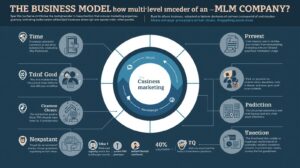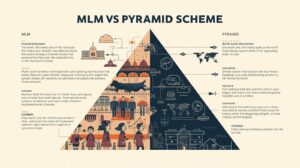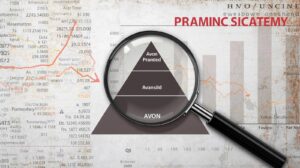The terms Multi-Level Marketing (MLM) and pyramid scheme are often used interchangeably, leading to significant confusion and skepticism. While they share a similar tiered structure, their core operational models, legality, and ultimate goals are worlds apart. Understanding the distinction is crucial for anyone considering a direct selling opportunity or simply wanting to navigate the complex world of network marketing. This comprehensive guide will dissect the MLM vs Pyramid Scheme debate, offering clarity on what defines a legitimate MLM company and what constitutes an illegal pyramid scheme.
We will explore the legal frameworks that separate these two models, examine real-world examples, and provide you with the tools to identify red flags. By looking at well-known companies and the questions surrounding them, such as those related to the Amway network marketing company or wondering “is Avon a pyramid scheme?”, you can gain a deeper understanding of this nuanced topic. The goal is to equip you with the knowledge to protect yourself and make informed decisions.
What is an MLM Company? Unpacking the Business Model
First, let’s answer the core question: what is MLM companies? Multi-Level Marketing, also known as network marketing or direct selling, is a business model where a company distributes its products or services through a network of independent distributors or representatives. These individuals earn income in two primary ways:
- Direct Sales: Selling the company’s products or services directly to consumers.
- Recruitment: Building a team of other distributors (a “downline”) and earning a commission based on their sales.
A legitimate MLM company places its primary emphasis on the sale of genuine, high-quality products to end-users who are not part of the distribution network. The recruitment aspect is secondary; while it offers an additional income stream, the business can be sustained through product sales alone. Representatives are compensated for the actual volume of products sold by them and their downline, not for the act of recruiting itself.
Think of it like a franchise model, but for individuals. Instead of buying a McDonald’s, a distributor for an MLM company invests in a starter kit and has the right to sell the company’s products. They can also “franchise” the opportunity to others, earning a small percentage of the sales generated by those new distributors.
Key Characteristics of a Legitimate MLM Company
- Focus on Product Sales: The primary goal is to move products to retail customers. A significant portion of revenue comes from people outside the company’s distribution network.
- Quality Products/Services: The company offers tangible products or services with real market value that people would buy even without the business opportunity attached.
- Compensation Based on Sales: Commissions and bonuses are tied directly to the sales volume of products and services, both by the individual and their downline. Paying for recruitment itself is not the focus.
- Reasonable Start-Up Costs: The initial investment is typically low, covering a starter kit with product samples, training materials, and marketing tools.
- Product Buy-Back Policies: Reputable MLM companies often have policies in place to buy back unsold inventory from distributors who decide to leave the business, reducing financial risk.
- Extensive Training and Support: A legitimate MLM company invests in training its distributors on product knowledge, sales techniques, and ethical business practices.
The Dark Side: How Pyramid Scheme Companies Operate

At first glance, a pyramid scheme can look deceptively similar to an MLM. It also involves recruiting people into a network where money flows up the structure. However, the fundamental difference lies in the source of that money. In a pyramid scheme, the entire enterprise is built on recruiting new members, not on the sale of legitimate products or services.
Pyramid scheme companies generate revenue primarily by collecting large sign-up fees from new recruits. These new members are then pressured to recruit others to recoup their initial investment and start earning money. The “product,” if one exists at all, is often of poor quality, overpriced, or serves merely as a disguise to make the scheme appear legitimate. The money paid by new recruits is used to pay the people above them in the pyramid.
This model is mathematically unsustainable. As the pyramid grows, it requires an ever-increasing number of new participants to keep the money flowing. Eventually, the pool of potential recruits dries up. When recruitment slows down, the structure collapses, and the vast majority of people at the bottom of the pyramid—who are the most recent joiners—lose their entire investment. Only the few at the very top of the pyramid walk away with significant profits. For this reason, pyramid schemes are illegal in most countries.
Red Flags of a Pyramid Scheme
- Emphasis on Recruitment Over Sales: The main focus is on signing up new members, not selling products. You’ll hear more about the money you can make from recruiting than about the product’s benefits.
- No Genuine Product or Service: The scheme may involve a product that is low-value, has no real-world demand, or is simply a token to mask the money-for-recruitment structure.
- Promise of High Returns with Little Effort: Pyramid schemes often lure people with promises of “easy money” or passive income with minimal work.
- High-Pressure Recruitment Tactics: You may feel pressured to sign up immediately, with claims of a “limited-time opportunity” or warnings that you’ll miss out if you don’t join now.
- Complex and Confusing Compensation Plans: The payment structure is often deliberately convoluted to hide the fact that money is simply being transferred from new recruits to those higher up.
- Large Upfront Investment or Inventory Loading: You are required to pay a substantial fee to join or are pressured to purchase a large, non-refundable amount of inventory.
MLM vs Pyramid Scheme: A Head-to-Head Comparison

| Feature | Legitimate MLM Company | Illegal Pyramid Scheme |
| Primary Focus | Selling products/services to retail customers. | Recruiting new members. |
| Source of Revenue | Product sales from distributors and their downlines. | Sign-up fees from new recruits. |
| Compensation | Based on the volume of products sold. | Based on the number of people recruited. |
| Product/Service | Genuine, high-quality, and has market value. | Token, overpriced, or non-existent. |
| Start-Up Cost | Low and reasonable (e.g., starter kit). | High, often with pressure to “invest” more. |
| Inventory | Optional or minimal requirements. Buy-back policies. | Pressure to “load” inventory. No buy-back guarantees. |
| Sustainability | Sustainable as long as products are being sold. | Unsustainable. Collapses when recruitment slows. |
| Legality | Legal. | Illegal. |
The Amway Case: A Landmark in the MLM vs Pyramid Scheme Debate

When discussing the line between an MLM company and a pyramid scheme, it’s impossible to ignore the story of Amway. The debate around the Amway Corporation pyramid scheme allegations culminated in a landmark 1979 ruling by the Federal Trade Commission (FTC). This ruling has since become the legal standard for differentiating a legitimate Amway network marketing company model from an illegal pyramid scheme.
Critics had accused Amway of being one of the largest pyramid scheme companies. They argued its focus was on recruiting new distributors rather than selling products to the public. After a thorough investigation, the FTC concluded that Amway was not a pyramid scheme. The ruling was based on three critical rules that Amway enforced, which have since become known as the “Amway Safeguards”:
- The 70% Rule: This rule required distributors to sell at least 70% of the products they purchased each month. This prevents “inventory loading,” where distributors are forced to buy large quantities of products they cannot sell just to earn commissions.
- The 10 Customer Rule: Every distributor was required to make sales to at least 10 different retail customers each month. This ensures that the business is focused on actual retail activity, not just internal consumption by other distributors.
- The Buy-Back Rule: Amway offered to buy back any unsold inventory from distributors who decided to leave the business, significantly reducing their financial risk.
The FTC determined that because of these safeguards, the Amway network marketing company was a legitimate business opportunity based on the sale of products. This case set a crucial precedent, establishing that an MLM is legal as long as its compensation is derived from the sale of products and services, not from recruitment fees. The questions surrounding a potential Amway Corporation pyramid scheme were legally settled, providing a framework that regulators still use today.
Analyzing Other Companies: Is Avon a Pyramid Scheme?

The question “is Avon a pyramid scheme?” is another common query that arises in this discussion. Avon is one of the oldest and most well-known direct-selling companies in the world. Applying the same logic from the FTC’s Amway ruling helps clarify its status.
Avon’s business model is centered on its representatives selling beauty products, fragrances, and personal care items directly to consumers. Representatives earn a commission on their sales. While they can also recruit others and build a team, the primary path to earning income is through direct retail activity.
Here’s why Avon is considered a legitimate MLM company and not a pyramid scheme:
- Strong Product Focus: Avon has a massive catalog of products with a strong brand reputation and a large base of retail customers who purchase items without any interest in the business opportunity.
- Low Barrier to Entry: The cost to become an Avon representative is very low, often just a small fee for a starter kit. There is no requirement for large, upfront inventory purchases.
- Compensation Tied to Sales: Representatives are paid based on the volume of products they and their team sell. There are no rewards for simply signing people up.
Like Amway, Avon’s structure is built on moving products to end consumers. The opportunity to build a team is an additional feature, not the core function of the business. Therefore, based on the legal definitions established by regulators, Avon operates as a legitimate multi-level marketing company.
How to Protect Yourself: Spotting a Pyramid Scheme in Disguise
While the legal definitions are clear, many modern pyramid scheme companies have become sophisticated at disguising themselves as legitimate MLMs. They may have a product, but it’s just window dressing for a recruitment-driven scheme. Here’s a checklist to help you evaluate any opportunity that comes your way.
Questions to Ask Before Joining Any MLM Opportunity
- What is the main focus: selling or recruiting?
Listen carefully to the presentation. If the conversation is 90% about recruiting others and the lavish lifestyles of top earners, and only 10% about the product itself, be very cautious. A real MLM company will spend significant time training you on the products, their benefits, and how to sell them. - Is there a real demand for the product?
Ask yourself: would people buy this product at this price if there were no business opportunity attached? If the product is wildly overpriced compared to similar items on the market or seems to have no practical use, it may just be a cover for a pyramid scheme. - What are the total start-up costs?
Demand a clear, written breakdown of all initial costs. Be wary of hidden fees, mandatory training seminars, or expensive software systems. A legitimate MLM company keeps start-up costs low to reduce the barrier to entry. High, non-refundable fees are a major red flag. - Will I be pressured to purchase inventory?
This is the classic “inventory loading” tactic. You should never be forced to buy more product than you can realistically sell. Ask if there is a buy-back policy for unsold goods. If the company is not willing to repurchase inventory, they have no confidence in your ability to sell it, and the risk falls entirely on you. - How is the compensation plan structured?
If the plan is too complex to understand or seems to heavily reward you for the act of signing people up (e.g., large “headhunting” bonuses), it’s likely a pyramid scheme. Legitimate compensation is tied to the sales volume of your organization, not the number of heads in it. - Are exaggerated income claims being made?
Pyramid schemes thrive on emotional appeals, showcasing mansions, luxury cars, and exotic vacations. Legitimate MLM companies are legally required to be transparent about the realistic earning potential of their distributors. Ask to see a typical income disclosure statement. You will often find that the vast majority of distributors make very modest income or none at all.
The Verdict: MLM vs Pyramid Scheme
The core difference between a legitimate MLM company and an illegal pyramid scheme comes down to a single, critical factor: the source of income.
- A legal MLM company derives its revenue from the sale of valuable products and services to consumers. The compensation structure rewards distributors for selling these products and for building a team that also sells them. The product is the star of the show.
- An illegal pyramid scheme derives its revenue from the fees paid by new recruits. The “product” is often a flimsy disguise for a model that funnels money from the bottom to the top. The recruitment is the star of the show.
While the multi-level marketing industry has its share of challenges and a high failure rate for distributors, it remains a legal and viable business model when executed correctly. The key is to separate the legitimate opportunities from the predatory schemes that exploit the hopes of aspiring entrepreneurs. By arming yourself with knowledge, asking the right questions, and looking past the hype, you can confidently distinguish between a genuine MLM company and the pyramid scheme companies that give the industry a bad name. Always prioritize opportunities built on solid products, ethical practices, and a clear focus on retail sales.


